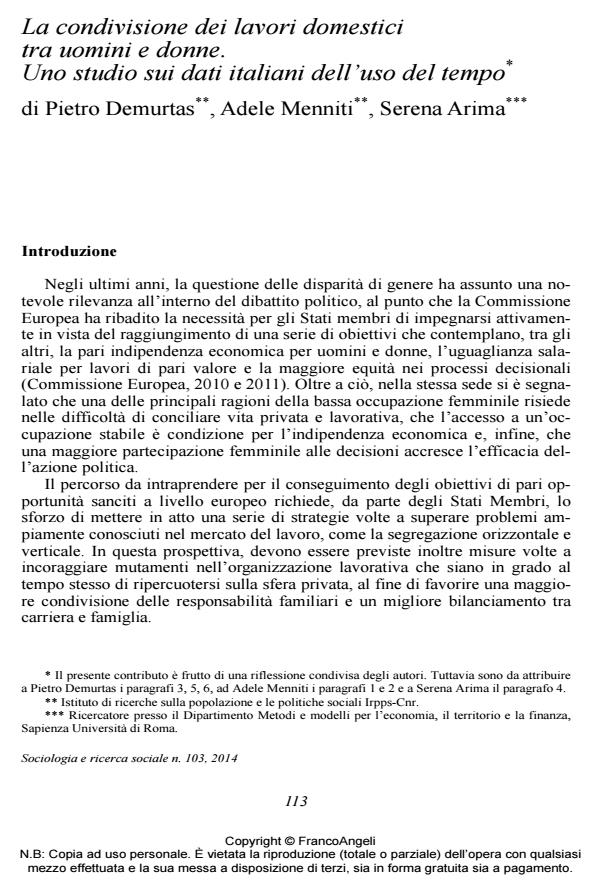La condivisione dei lavori domestici tra uomini e donne. Uno studio sui dati italiani dell’uso del tempo
Titolo Rivista SOCIOLOGIA E RICERCA SOCIALE
Autori/Curatori Pietro Demurtas, Adele Menniti, Serena Arima
Anno di pubblicazione 2014 Fascicolo 2014/103
Lingua Italiano Numero pagine 32 P. 113-144 Dimensione file 169 KB
DOI 10.3280/SR2014-103006
Il DOI è il codice a barre della proprietà intellettuale: per saperne di più
clicca qui
Qui sotto puoi vedere in anteprima la prima pagina di questo articolo.
Se questo articolo ti interessa, lo puoi acquistare (e scaricare in formato pdf) seguendo le facili indicazioni per acquistare il download credit. Acquista Download Credits per scaricare questo Articolo in formato PDF

FrancoAngeli è membro della Publishers International Linking Association, Inc (PILA)associazione indipendente e non profit per facilitare (attraverso i servizi tecnologici implementati da CrossRef.org) l’accesso degli studiosi ai contenuti digitali nelle pubblicazioni professionali e scientifiche
Among European countries, Italian couples show one of the widest gender gaps in housework division: Italian women still carry out three-quarters of family labour. Following the existing literature, this article focuses on three theoretical explanations of the persistence of the gendered division of unpaid work: time availability, relative resources, and conformity to traditional gender ideology. Time-Use data from the 2008/2009 Survey edition has been used to study the behaviour of Italian couples, married or living together, where the women are employed. The amount of time spent by men and women in domestic tasks has been modelled as function of several family characteristics and a Tobit model has been used in order to take into account the truncated nature of the dependent variables. Results show that the amount of time dedicated by women to housework significantly decreases when they take on the role of breadwinner, whereas the involvement in domestic tasks of male partners increases when they are unemployed. Therefore, in conformity with the expectations of relative resources’ hypothesis, Italian data shows a positive impact of the female financial capacity in reducing gender segregation in housework.
- La quotidianità in famiglia, tra riproduzione e superamento delle differenze di genere Pietro Demurtas, in WELFARE E ERGONOMIA 2/2017 pp.175
DOI: 10.3280/WE2015-002014 - Modelli di genere e attività domestiche: genitori e figli a confronto Pietro Demurtas, Adele Menniti, Loredana Cerbara, in SOCIOLOGIA E RICERCA SOCIALE 110/2016 pp.84
DOI: 10.3280/SR2016-110006
Pietro Demurtas, Adele Menniti, Serena Arima, La condivisione dei lavori domestici tra uomini e donne. Uno studio sui dati italiani dell’uso del tempo in "SOCIOLOGIA E RICERCA SOCIALE " 103/2014, pp 113-144, DOI: 10.3280/SR2014-103006